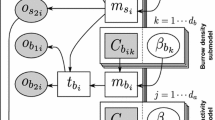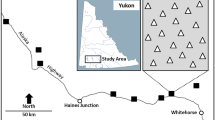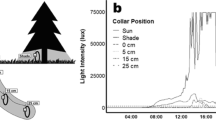Abstract
We investigated the roles of vegetation structure, micro-topographic relief, and predator activity patterns (time of day) on the perception of predatory risk of arctic ground squirrels (Urocitellus parryii), an abundant pan-Arctic omnivore, in Arctic Circle tundra on the North Slope of Alaska, where tundra vegetation structure has been predicted to change in response to climate. We quantified foraging intensity by measuring the giving-up densities (GUDs) of the arctic ground squirrels in experimental foraging patches along a heath–graminoid–shrub moist tundra gradient. We hypothesized that foraging intensity of arctic ground squirrels would be greatest and GUDs lowest, where low-stature vegetation or raised micro-topography improves sightlines for predator detection. Furthermore, GUDs should vary with time of day and reflect 24-h cycles of varying predation risk. Foraging intensity varied temporally, being highest in the afternoon and lowest overnight. During the morning, foraging intensity was inversely correlated with the normalized difference vegetation index (NDVI), a proxy for vegetation productivity and cover. Foraging was additionally measured within landscapes of fear, confirming that vegetative and topographic obstructions of sightlines reduces foraging intensity and increases GUDs. We conclude that arctic ground squirrels may affect Arctic Circle vegetation of tundra ecosystems, but these effects will vary spatially and temporally.






Similar content being viewed by others
References
Abu Baker MA, Brown JS (2012) Patch use behaviour of Elephantulus myurus and Micaelamys namaquensis: the role of diet, foraging substrates and escape substrates. African J Ecol 50:167–175
Albon SD, Irvine RJ, Halvorsen O, Langvatn R, Loe LE, Ropstad E, Veiberg V, Wal R, Bjørkvoll EM, Duff EI, Hansen BB (2017) Contrasting effects of summer and winter warming on body mass explain population dynamics in a food-limited Arctic herbivore. Global Change Biol 23:1374–1389
Altendorf KB, Laundre JW, Lopez Gonzalez CA, Brown JS (2001) Assessing effects of predation risk on foraging behavior of mule deer. J Mammal 82:430–439. https://doi.org/10.1644/1545-1542(2001)082%3c0430:aeopro%3e2.0.co;2
Anandhi A (2016) Growing degree days—Ecosystem indicator for changing diurnal temperatures and their impact on corn growth stages in Kansas. Ecol Indicators 61:149–158
Anderson-Smith M (2013) Remotely-sensed spectral data linked to increasing shrub abundance and greater growing season carbon uptake in Alaska Arctic Tundra. M.Sc. Thesis, Department of Biological Sciences, University of Alaska Anchorage, USA
Barker OE, Derocher AE (2010) Habitat selection by arctic ground squirrels (Spermophilus parryii). J Mammal 91:1251–1260. https://doi.org/10.1644/10-MAMM-A-030.1
Barker OE, Derocher AE, Edwards MA (2015) Use of Arctic ground squirrels (Urocitellus parryii) by brown bears (Ursus arctos). Polar Biol 38:369–379
Batzli GO, Sobaski ST (1980) Distribution, abundance, and foraging patterns of ground squirrels near Atkasook, Alaska. Arct Alp Res 12:501–510
Bedoya-Perez MA, Carthey AJR, Mella VSA, McArthur C, Banks PB (2013) A practical guide to avoid giving up on giving-up densities. Behav Ecol Sociobiol 67:1541–1553. https://doi.org/10.1007/s00265-013-1609-3
Bjorkman AD, Elmendorf SC, Beamish AL, Vellend M, Henry GH (2015) Contrasting effects of warming and increased snowfall on Arctic tundra plant phenology over the past two decades. Glob Change Biol 21:4651–4661
Blanc-Betes E, Welker JM, Sturchio NC, Chanton JP, Gonzalez-Meler MA (2016) Winter precipitation and snow accumulation drive the methane sink or source strength of Arctic tussock tundra. Glob Change Biol 22:2818–2833
Boelman NT, Krause JS, Sweet SK, Chmura HE, Perez JH, Gough L, Wingfield JC (2017) Extreme spring conditions in the Arctic delay spring phenology of long-distance migratory songbirds. Oecologia 185:69–80
Brown JS (1988) Patch use as an indicator of habitat preference, predation risk, and competition. Behav Ecol Sociobiol 22:37–47. https://doi.org/10.1007/BF00395696
Brown JS, Kotler BP (2004) Hazardous duty pay and the foraging cost of predation. Ecol Lett 7:999–1014. https://doi.org/10.1111/j.1461-0248.2004.00661.x
Buck CL, Barnes BM (1999) Annual cycle of body composition and hibernation in free-living arctic ground squirrels. J Mammal 80:430–442
Carl EA (1971) Population control in arctic ground squirrels. Ecology 52:395. https://doi.org/10.2307/1937623
Chalfoun AD, Martin TE (2009) Habitat structure mediates predation risk for sedentary prey: experimental tests of alternative hypotheses. J Animal Ecol 78:497–503
Crowder LB, Cooper WE (1982) Habitat structural complexity and the interaction between bluegills and their prey. Ecology 63:1802–1813
Donker SA, Krebs CJ (2012) Evidence for sourcesink dynamics in a regional population of arctic ground squirrels (Urocitellus parryii plesius). Wildl Res 39:163–170. https://doi.org/10.1071/WR11167
Fanson BG, Fanson KV, Brown JS, Brown JS (2010) Ecological factors affecting the foraging behaviour of Xerus rutilus. Afr Zoo 45:265–272
Flower CE, Gonzalez-Meler MA (2015) Responses of temperate forest productivity to insect and pathogen disturbances. Annu Rev Plant Biol 66:547–569. https://doi.org/10.1146/annurev-arplant-043014-115540
Flower CE, Knight KS, Gonzalez-Meler MA (2013) Impacts of the emerald ash borer (Agrilus planipennis fairmaire) induced ash (Fraxinus spp.) mortality on forest carbon cycling and successional dynamics in the eastern United States. Biol Invasions 15:931–944. https://doi.org/10.1007/s10530-012-0341-7
Fung I (1997) A greener north. Nature 386:659–660
Gillis EA, Morrison SF, Zazula GD, Hik DS (2005) Evidence for selective caching by Arctic ground squirrels living in alpine meadows in the Yukon. Arctic 58:354–360
Gough L, Moore JC, Shaver GR, Simpson RT, Johnson DR (2012) Above- and belowground responses of arctic tundra ecosystems to altered soil nutrients and mammalian herbivory. Ecology 93:1683–1694. https://doi.org/10.1890/11-1631.1
Hall ER (1981) The Mammals of North America, 2nd edn. John Wiley & Sons, New York
Hope AS, Kimball JS, Stow DA (1993) The relationship between tussock tundra spectral reflectance properties and biomass and vegetation composition. Int J Remote Sensing 14:1861–1874
Iribarren C, Kotler BP (2012) Foraging patterns of habitat use reveal landscape of fear of Nubian ibex Capra nubiana. Wildl Biol. 18:194–201
Karels TJ, Boonstra R (1999) The impact of predation on burrow use by arctic ground squirrels in the boreal forest. Proc Biol Sci 266:2117–2123. https://doi.org/10.1098/rspb.1999.0896
Kotler BP (1984) Effects of illumination on the rate of resource harvesting in a community of desert rodents. Am Midl Nat 111:383–389
Kotler BP, Morris DW, Brown JS (2016) Direct behavioral indicators as a conservation and management tool. In: Berger-Tal O, Saltz D (eds) Conservation behavior: applying behavioral ecology to wildlife conservation and management. Cambridge University Press, Cambridge, pp 307–351
Laundré JW, Hernández L, Medina PL, Campanella A, López-Portillo J, González-Romero A, Grajales-Tam KM, Burke AM, Gronemeyer P, Browning DM (2014) The landscape of fear: the missing link to understand top-down and bottom-up controls of prey abundance? Ecology 95:1141–1152
Leffler AJ, Klein ES, Oberbauer SF, Welker JM (2016) Coupled long-term summer warming and deeper snow alters species composition and stimulates gross primary productivity in tussock tundra. Oecologia 181:287–297. https://doi.org/10.1007/s00442-015-3543-8
Leffler AJ, Beard KH, Kelsey KC, Choi RT, Schmutz JA, Welker JM (2019) Delayed herbivory by migratory geese increases summer-long CO2 uptake in coastal western Alaska. Glob Change Biol. 25:277–289. https://doi.org/10.1111/gcb.14473
Lima SL (1987) Distance to cover, visual obstructions, and vigilance in house sparrows. Behaviour 102:231–237
Long RA, Martin TJ, Barnes BM (2005) Body temperature and activity patterns in free-living arctic ground squirrels. J Mamm 86:314–322. https://doi.org/10.1644/BRG-224.1
McKendrick JD, Batzli GO, Everett KR, Swanson JC (1980) Some effects of mammalian herbivores and fertilization on tundra soils and vegetation. Arct Alp Res Arct and Alpine Res 12:565–578. https://doi.org/10.2307/1550501
Myers-Smith IH, Forbes BC, Wilmking M, Hallinger M, Lantz T, Blok D, Tape KD, Macias-Fauria M, Sass-Klaassen U, Lévesque E, Boudreau S, Ropars P, Hermanutz L, Trant A, Collier LS, Weijers S, Rozema J, Rayback SA, Schmidt NM, Schaepman-Strub G, Wipf S, Rixen C, Ménard CB, Venn S, Goetz S, Andreu-Hayles L, Elmendorf S, Ravolainen VT, Welker J, Grogan P, Epstein HE, Hik DS (2011) Shrub expansion in tundra ecosystems: dynamics, impacts and research priorities. Environ Res Lett 6:45509. https://doi.org/10.1088/1748-9326/6/4/045509
Myneni RB, Keeling CD, Tucker CJ, Asrar G, Nemani RR (1997) Increased plant growth in the northern high latitudes from 1981 to 1991. Nature 386:698–702
Parmesan C, Yohe G (2003) A globally coherent fingerprint of climate change impacts across natural systems. Nature 421:37–42. https://doi.org/10.1038/nature01286
Partain JL, Alden S, Bhatt US, Bieniek PA, Brettschneider BR, Lader RT, Olsson PQ, Rupp TS, Strader H, Thoman RL, Walsh JE, York AD, Ziel RH (2016) An assessment of the role of anthropogenic climate change in the Alaska fire season of 2015. Bull Am Meteorol Soc 97:S14–S18. https://doi.org/10.1175/BAMS-D-16-0149.1
Shrader AM, Brown JS, Kerley GIH, Kotler BP (2008) Do free-ranging domestic goats show ‘landscapes of fear’? Patch use in response to habitat features and predator cues. J. Arid Env. 72:1811–1819. https://doi.org/10.1890/0012-9658(2000)081%5b0078:DAIEOH%5d2.0.CO;2
Tadesse SA, Kotler BP (2013) Habitat use by mountain nyala Tragelaphus buxtoni determined using stem bite diameters at point of browse, bite rates, and time budgets in the Bale Mountains National Park, Ethiopia. Curr Zoo. 59:707–717
Tape KEN, Sturm M, Racine C (2006) The evidence for shrub expansion in northern Alaska and the Pan-Arctic. Glob Change Biol 12:686–702
Thorson JM, Morgan RA, Brown JS, Norman JE (1998) Direct and indirect cues of predatory risk and patch use by fox squirrels and thirteen-lined ground squirrels. Behav Ecol 9:151–157
van der Merwe M, Brown JSM (2008) Mapping the landscape of fear of the cape ground squirrel (Xerus inauris). J. Mamm. 89:1162–1169
Walker MD, Walker DA, Auerbach NA (1994) Plant communities of a tussock tundra landscape in the Brooks Range Foothills, Alaska. J Veg Sci 6:843–866
Warfe DM, Barmuta LA (2004) Habitat structural complexity mediates the foraging success of multiple predator species. Oecologia 141:171–178
Wheeler HC, Hik DS (2014) Giving-up densities and foraging behaviour indicate possible effects of shrub encroachment on arctic ground squirrels. Anim Behav 95:1–8. https://doi.org/10.1016/j.anbehav.2014.06.005
Wheeler HC, Chipperfield JD, Roland C, Svenning JC (2015) How will the greening of the Arctic affect an important prey species and disturbance agent? Vegetation effects on arctic ground squirrels. Oecologia 178:915–929. https://doi.org/10.1007/s00442-015-3240-7
Williams CT, Wilsterman K, Kelley AD, Breton AR, Stark H, Humphries MM, McAdam AG, Barnes BM, Boutin S, Buck CL (2014) Light loggers reveal weather-driven changes in the daily activity patterns of arboreal and semifossorial rodents. J Mammol 95:1230–1239. https://doi.org/10.1644/14-MAMM-A-062
Zazula GD, Mathewes RW, Harestad AS (2006) Cache selection by arctic ground squirrels inhabiting Boreal-steppe meadows of southwest Yukon territory, Canada. Arctic Antarct Alp Res 38:631–638. https://doi.org/10.1657/1523-0430(2006)38%5b631:CSBAGS%5d2.0.CO;2
Acknowledgements
This research was supported by the US Department of Energy, Terrestrial Ecosystem Science Program (DE-SC 0006607 to MAG-M), a grant by the College of Liberal Arts and Sciences (MAG-M), the Stable Isotope Laboratory at the Department of Biological Sciences at UIC, and the International Tundra Experiment (ITEX). The authors thank N. van Hoey, J.M. Welker, and M. Anderson-Smith for support with NDVI measurements, staff at NSF LTER/Toolik Field Station and GIS Office (R. Fulweber). E. Blanc-Betes and M. Ricketts provided useful feedback during the experimentation and data analyses. A. H. Halloway kindly assisted with data analysis. Weather datasets were provided by the Toolik Field Station Environmental Data Center. JED thanks the Grant-in-Aid of Research support from the American Society of Mammalogists, and the Department of Biological Sciences and the College of Liberal Arts and Sciences at the University of Illinois at Chicago for providing additional support. CEF recognizes the USDA Forest Service Northern Research Station for helping to support his travel in 2014.
Author information
Authors and Affiliations
Contributions
All authors contributed to the final version of the manuscript. Author contributions: All authors shared equally with the conception and execution of the experiment. JSB, CJW, and CEF conducted the statistical analyses.
Corresponding author
Ethics declarations
Conflict of interest
The authors declare that they have no conflict of interest in the authorship of this article.
Ethical approval
All applicable institutional and/or national guidelines for the care and use of animals were followed.
Additional information
Communicated by Peter Banks.
Electronic supplementary material
Below is the link to the electronic supplementary material.
Rights and permissions
About this article
Cite this article
Flower, C.E., Dalton, J.E., Whelan, C.J. et al. Patch use in the arctic ground squirrel: effects of micro-topography and shrub encroachment in the Arctic Circle. Oecologia 190, 243–254 (2019). https://doi.org/10.1007/s00442-019-04400-5
Received:
Accepted:
Published:
Issue Date:
DOI: https://doi.org/10.1007/s00442-019-04400-5




